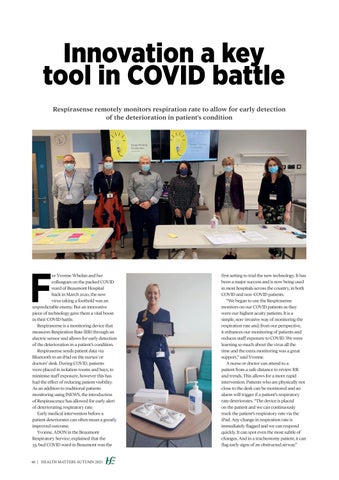Innovation a key tool in COVID battle Respirasense remotely monitors respiration rate to allow for early detection of the deterioration in patient's condition
F
or Yvonne Whelan and her colleagues on the packed COVID ward of Beaumont Hospital back in March 2020, the new virus taking a foothold was an unpredictable enemy. But an innovative piece of technology gave them a vital boost in their COVID battle. Respirasense is a monitoring device that measures Respiration Rate (RR) through an electric sensor and allows for early detection of the deterioration in a patient’s condition. Respirasense sends patient data via Bluetooth to an iPad on the nurses’ or doctors’ desk. During COVID, patients were placed in isolation rooms and bays, to minimise staff exposure, however this has had the effect of reducing patient visibility. As an addition to traditional patients monitoring using INEWS, the introduction of Respirascence has allowed for early alert of deteriorating respiratory rate. Early medical intervention before a patient deteriorates can often mean a greatly improved outcome. Yvonne, ADON in the Beaumont Respiratory Service, explained that the 35-bed COVID ward in Beaumont was the
first setting to trial the new technology. It has been a major success and is now being used in most hospitals across the country, in both COVID and non-COVID patients. “We began to use the Respirasense monitors on our COVID patients as they were our highest acuity patients. It is a simple, non-invasive way of monitoring the respiration rate and, from our perspective, it enhances our monitoring of patients and reduces staff exposure to COVID. We were learning so much about the virus all the time and the extra monitoring was a great support,” said Yvonne. A nurse or doctor can attend to a patient from a safe distance to review RR and trends. This allows for a more rapid intervention. Patients who are physically not close to the desk can be monitored and an alarm will trigger if a patient’s respiratory rate deteriorates. “The device is placed on the patient and we can continuously track the patient’s respiratory rate via the iPad. Any change in respiration rate is immediately flagged and we can respond quickly. It can spot even the most subtle of changes. And in a tracheotomy patient, it can flag early signs of an obstructed airway.”
46 | HEALTH MATTERS AUTUMN 2021
046 HSE Health Matters_ Respirasense_Service.indd 46
08/09/2021 15:25















































